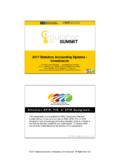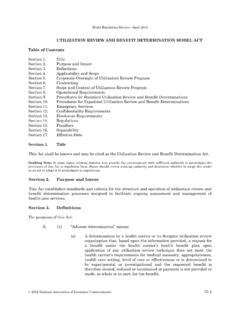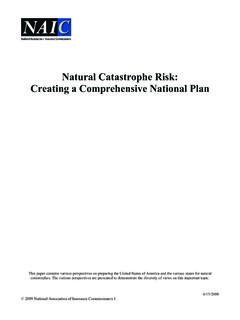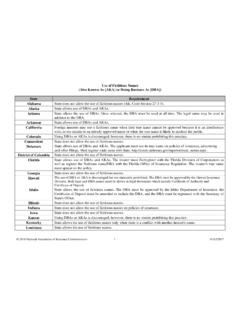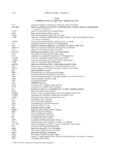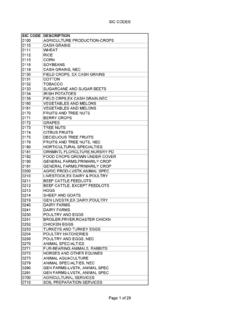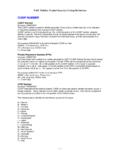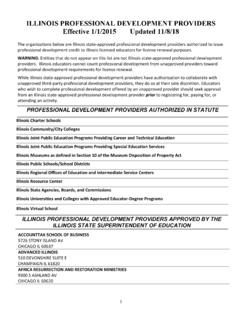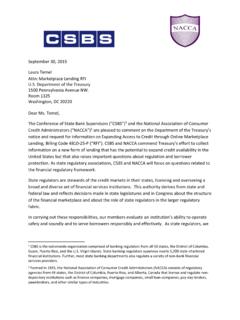Transcription of Number of Insurance Companies U.S. Premiums by …
1 The mission of the national association of Insurance Commissioners (NAIC) is to assist state Insurance regulators, individually and collectively, in serving the public interest and achieving the following fundamental Insurance regulatory goals in a responsive, efficient and cost effective manner, consistent with the wishes of its members. As part of this mission, the NAIC compiles meaningful data about the Insurance regulatory community, as well as the Insurance industry. Number of Insurance Companies The Number of Insurance Companies is provided by state Insurance regulators and is compiled annually by the NAIC.
2 Depending on the type of Insurance Companies provided, they are classified either as property/casualty, life, health, fraternal or title insurers. Insurers with primary corporate headquarters located in a particular state are called domestic insurers. The Insurance regulator in the insurer s state of domicile is the primary regulator of that insurer. Foreign insurers are those that are allowed to sell Insurance in a state but have a primary legal residence in another state. The state rank represents the rank relative to the state with the largest Number of insurers among all states. Premiums by NAIC Financial Statement Type The premium volume from the NAIC financial filing database is direct written premium derived from insurer annual financial statement filings provided to the NAIC.
3 The total is comprised of aggregate premium and deposits generated without any adjustments for reinsurance. This data is grouped according to insurer financial statement filing type ( , property/casualty; life, accident and health; health; fraternal organizations; and title). Data in one financial statement type could contain data that seemingly fits better under another line of business. For example, traditional health data may be filed by an insurer using the filing type of life, accident and health. Depending on the regulatory requirements in the state of domicile, captives and risk retention groups are not always required to file with the NAIC and, consequently, this data may not be considered complete.
4 Not all state funds are required to file with the NAIC. State fund data contained herein is reported separately and added to the premium volume during composition of this report. Some categories are modified to more closely align with the structure of the NAIC financial statement filings and may not be comparable to data reported in prior years. The state rank represents the rank relative to the state with the largest premium volume among all states. Premiums by IDRR Premium Type The premium volume from the Insurance Department Resources Report (IDRR) is comprised of direct written premium that the states report to the NAIC in compiling the IDRR.
5 This data is grouped by type of business and will not match up with data grouped by NAIC financial statement type. This data includes total direct written premium reported by each state Insurance department and does not include Premiums from captives or surplus lines business. It was requested that each state include state funds in its premium volume reported. Some Companies may report premium data to the state Insurance department that are not required to report to the NAIC due to sales volume or other regulatory requirements of their domiciliary state. Insurance Department Data The Insurance department data is provided by state Insurance regulators and is compiled annually by the NAIC.
6 Total taxes include premium, retaliatory, franchise and income taxes paid by insurers. Total revenue includes other sources of revenue, such as licensing fees and fines and assessments, as well as total taxes. Total budget represents the annual operating budget of the state Insurance department. Total employment is the Number of full-time state Insurance department employees. The state rank represents the rank relative to the state with the largest respective Number among all states. Cost of Regulation The cost of regulation is calculated from data supplied by state Insurance regulators and collected from insurers financial filings. It is a ratio that compares the Insurance department budget to total premium written in the state.
7 Beginning with the 2010 IDRR, Insurance budget data no longer includes pass-through funding. Budget figures from 2008 and forward were adjusted to reflect this change. For state-specific details, please refer to the IDRR technical notes. Property/Casualty Premium by Line of Business The Premiums are from the annual financial statement information that property/casualty insurers file with the NAIC. Property/casualty premium is subdivided into several categories. This data includes information on state funds reported separately and added to the premium volume during composition of this report. The state rank represents the rank relative to the state with the largest respective premium by line of business among all states.
8 Insurance Industry Employment The Bureau of Labor Statistics (BLS) produces the Quarterly Census of Employment and Wages (QCEW). The QCEW is derived from quarterly unemployment Insurance tax reports submitted by employers to state workforce agencies. The reports are subject to state unemployment Insurance laws, as well as to the Unemployment Compensation for Federal Employees (UCFE) program. According to the BLS, the QCEW program publishes a quarterly count of employment and wages covering 98% of jobs, available by industry in the county, metropolitan statistical area (MSA), state and national levels. Employment is the total Number of persons employed full-time or part-time in non-farm establishments during a specified payroll period.
9 Temporary employees are included. In general, data refer to persons who worked during, or received pay for, any part of the pay period that includes the 12th of the month, which is standard for all federal agencies collecting employment data from business establishments. Insurance carriers include employees of direct insurers from all Insurance types and reinsurers. Agencies, brokerages and other Insurance -related activities include Insurance agents and brokers, independent claims adjusters, third-party administrators of Insurance and pension funds, and other Insurance -related activities. Consumer Complaints Complaints include all formal complaints lodged with the Insurance department.
10 Consumer Inquiries Inquiries include all requests for information about Insurance -related issues made by any medium, including phone calls, written letters, emails, etc. Requests for brochures are included, as are incidents where a complaint is voiced, but is not formally lodged. Gross Domestic Product The Bureau of Economic Analysis (BEA) produces the gross domestic product (GDP). The BEA defines GDP by state as the most comprehensive measure of overall economic activity in the individual states. Per the BEA, GDP by state is calculated as the sum of incomes earned by labor and capital and the costs incurred in the production of goods and services.
